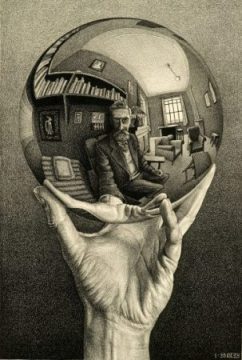
Documentary gazes into the complex world of M. C. Escher
M. C. ESCHER: JOURNEY TO INFINITY (Robin Lutz, 2019)
New Plaza Cinema
Opens virtually February 5
kinomarquee.com
newplazacinema.org
Maurits Cornelis Escher, better known as M. C. Escher, is one of the most popular graphic artists of the twentieth century, even though he considered himself a mathematician, not an artist. His fantastical works, often of impossible architectural configurations, are imbedded with a scientific surrealism that has made them favorites on T-shirts, posters, placemats, puzzles, album covers, ads, and tattooed body parts. In 2019, the traveling show “Escher: The Exhibition & Experience” came to Industry City in Brooklyn; the Italian-sponsored presentation included lots of Instagram-friendly installations that invited visitors to put themselves inside some of Escher’s most famous pieces. But who was the Dutch artist?
At the beginning of Robin Lutz’s documentary, M. C. Escher: Journey to Infinity, there’s a shot of fingers typing out the following: “I’m afraid there is only one person in the world who could make a good film about my prints; me.” And so it is; the movie is structured around Escher’s own words, compiled from his notes, journals, lectures, calendars, and letters, elegantly narrated by British actor Stephen Fry. The only talking heads who share their thoughts are two of Escher’s children, George and Jan Escher, and one of Escher’s daughters-in-law, along with, curiously enough, superfan Graham Nash. “I cannot understand why the out-of-control youths of today appreciate my works so much,” Escher says of late-1960s psychedelic re-creations of his butterflies and geometric space objects. Of course, it’s easy to tell what drew, and continues to draw, so many to his artistry.
Supplemented by archival photographs and film footage, Lutz traces Escher’s life and career from his love of drawing as a child and his studies at the Haarlem School of Architecture and Decorative Artists to his falling in love with Jetta Umiker, a romance he explains in rather unique language. His description of a picture of a seemingly endless winding road of trees is particularly revealing, accompanied by the sounds of an echoing church organ, played at St. Bartholomew’s in Haarlem, where Escher honed his craft. The camera focuses on a pair of feet treading the same paths that Escher took, as if he himself is leading us on this journey, focusing on rocks, flowers, birds, leaves, chameleons, and other elements that became his subject matter.
At the age of forty, he writes about his evolving process, involving systematism, recognizability, and the importance of background: “I have things of my own that had to come out, that I could express something others don’t have. . . For me, this is the richest of times.” The film grows richer as well as Escher shares insight behind the creation of some of his most famous works while also discussing isolation, human contact, and the horrors of Fascism and WWII. In addition, Lutz, who also served as producer and cinematographer, has plenty of fun with animation, bringing works to life, from a skull floating through the clouds to moving chess pieces to figures going up and down impossible staircases.
Breathlessly edited by Moek de Groot, M. C. Escher: Journey to Infinity is a pure joy because Lutz lets Escher, who passed away in 1972 at the age of seventy-three, run the show, his words poetic and passionate, the images captivating and mind-bending, infused with an infectious, futuristic energy that transcends the now. It’s an exciting trip deep into one man’s relationship with a complex world that he captured in extraordinary artworks that are likely to dazzle and confound viewers for a long time to come.